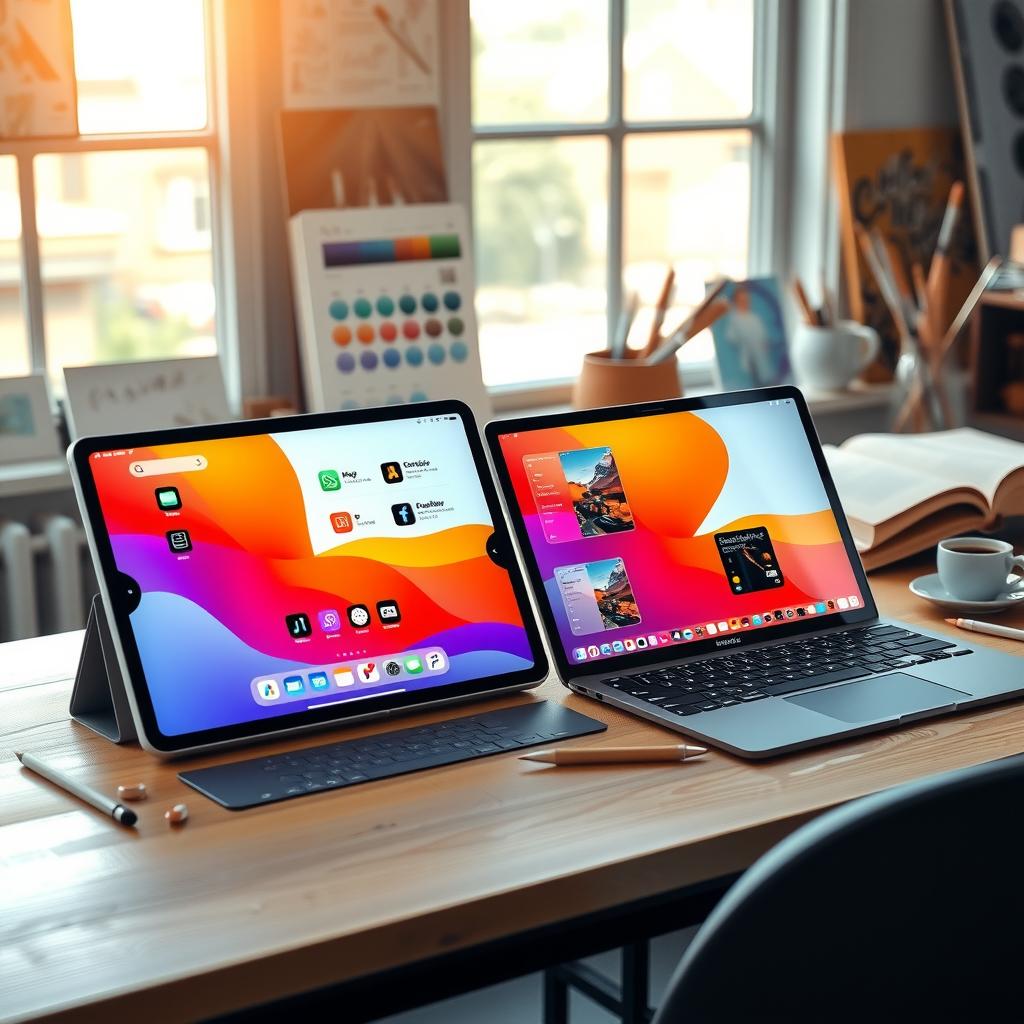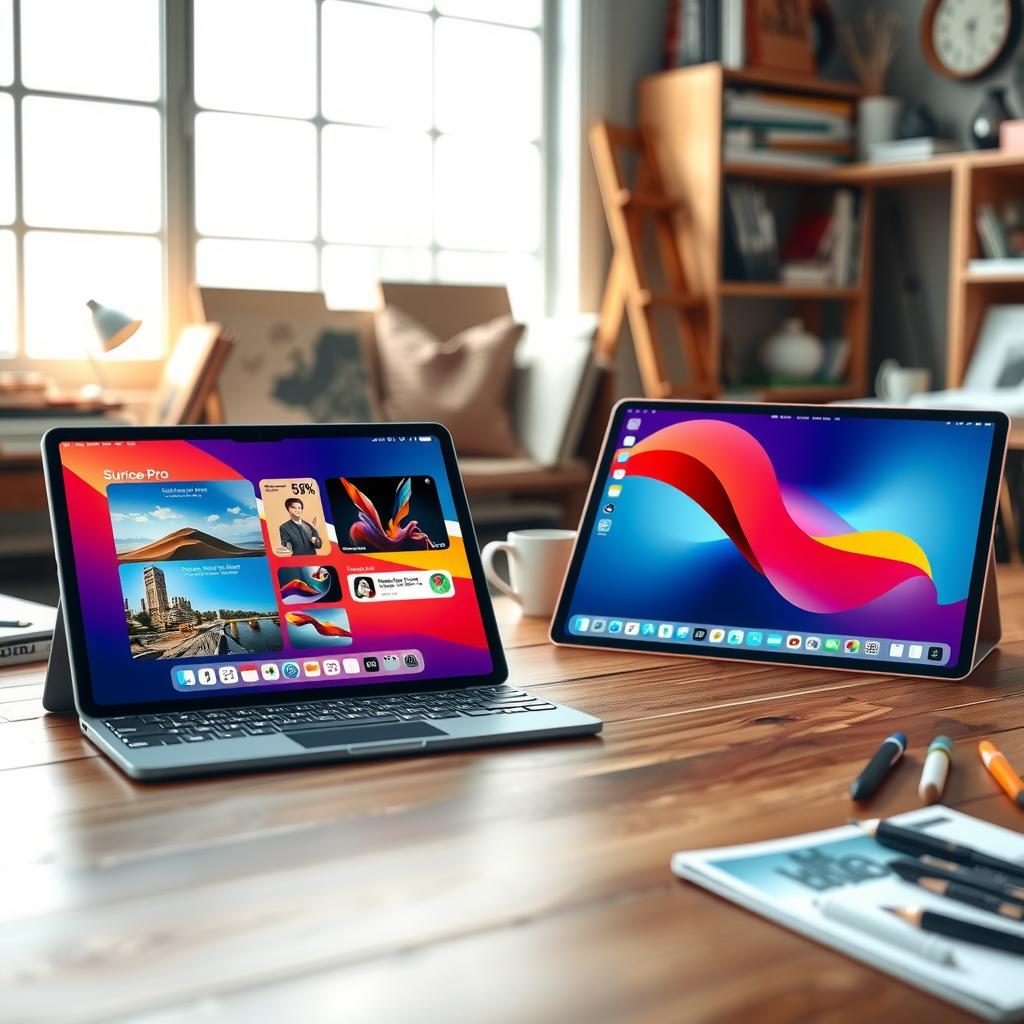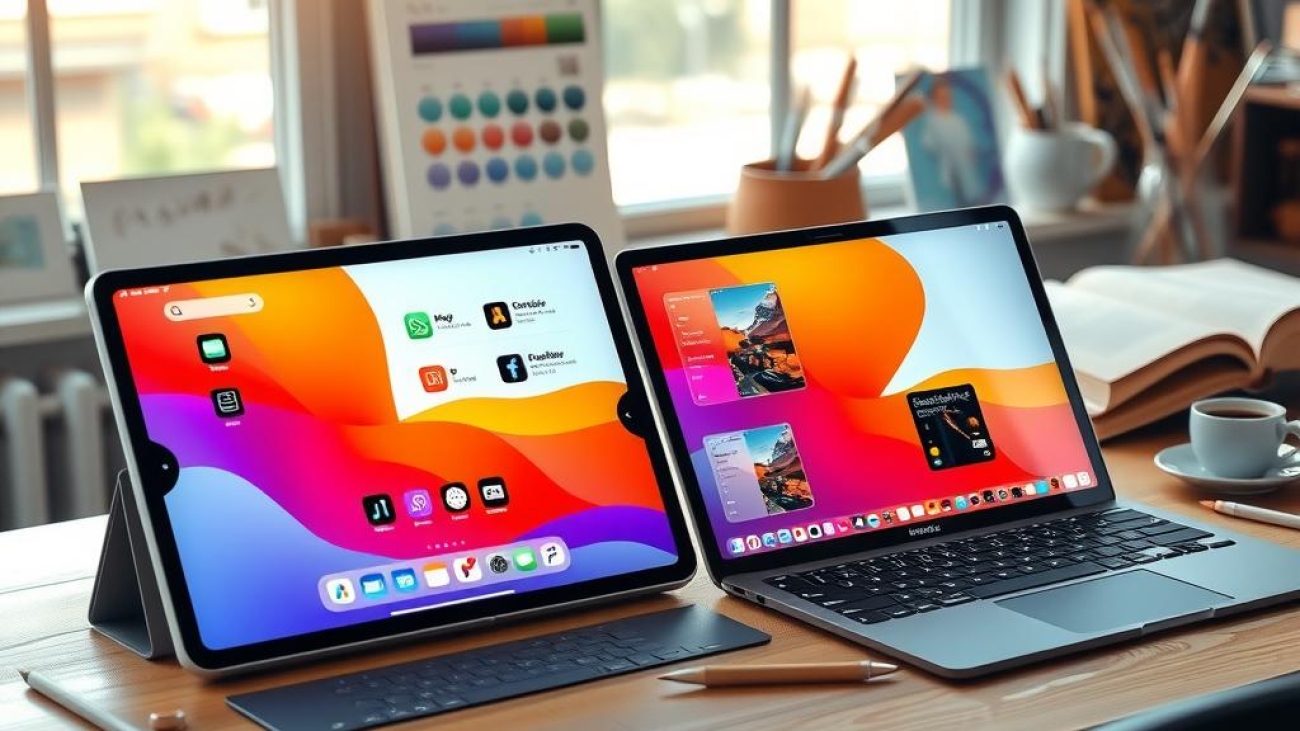In the realm of remote work, where creative professionals thrive on flexibility and innovation, the choice of a mobile workstation can significantly influence productivity. As digital creativity becomes increasingly essential in today’s fast-paced environment, many are left wondering: which device truly stands out for those who rely heavily on design software? Enter the debate between two titans in the tablet arena—the iPad Pro and the Surface Pro. Each offers a unique set of features tailored to meet the diverse needs of remote creators, but their capabilities differ in ways that could make or break a professional’s workflow efficiency.
The core value of this comparison lies not only in hardware specifications but also in how these devices integrate into a creative professional’s daily routine. With an increasing number of artists, designers, and content creators seeking versatile tools that support their artistic vision while ensuring seamless operation across various platforms, understanding each product’s strengths is crucial. The iPad Pro boasts impressive performance with its M1 chip and vibrant display that elevates graphic design tasks to new heights; meanwhile, the Surface Pro emphasizes versatility with its detachable keyboard and Windows integration that appeals to users accustomed to traditional computing environments.
As we delve deeper into this performance comparison between iPad Pro and Surface Pro, it will become evident how each device caters differently to aspects like app availability for creative pursuits or compatibility with industry-standard programs. For instance, while both tablets excel at running popular design software efficiently—be it Adobe Creative Suite or specialized drawing applications—their operating systems dictate user experience profoundly. This analysis aims not merely to highlight differences but also guide remote workers toward selecting the productivity tool best suited for their specific workflows.
By examining critical factors such as battery life during intensive use sessions or stylus responsiveness during high-pressure projects—elements vital for enhancing overall productivity—we invite readers into an exploration designed specifically for professionals navigating today’s dynamic work landscape. Therefore, whether one leans towards Apple’s sleek ecosystem with its robust suite of apps or favors Microsoft’s functionality within familiar territory will ultimately shape their approach to digital artistry.
With so much at stake regarding equipment choices impacting creativity on-the-go, it’s time for remote professionals to weigh these options carefully and determine which mobile workstation aligns best with their artistic aspirations. Join us as we unfold this intricate narrative around choosing between iPad Pro vs Surface Pro, setting up any aspiring creator for success amidst challenges encountered along their journey through digital realms.

Key Insights:
-
Device Versatility: The choice between the iPad Pro and Surface Pro hinges on users’ software needs. While the iPad Pro excels in delivering a smooth touch interface with app optimization for creatives, the Surface Pro provides access to traditional desktop applications, making it a powerful option for those relying on robust design software.
-
Performance Factors: When assessing performance comparison aspects like battery life and display quality, both devices have their strengths. The high-resolution display of the iPad Pro, combined with its superior color accuracy, can be essential for artists focused on detail. Conversely, the Surface Pro’s extensive compatibility with various productivity tools makes it suitable for multitasking professionals engaged in remote work.
-
Mobility and Workflow Efficiency: As creative professionals navigate diverse projects remotely, mobility becomes critical. The lightweight design of both the iPad Pro and the Surface Pro supports effortless transportability; however, each device’s unique features contribute differently to workflow efficiency. Artists may find that using an Apple Pencil with their iPad Pro enhances sketching experiences while others might prefer the familiar desktop environment provided by the versatile capabilities of the Surface Pro.

The New Normal of Creative Workspaces
How Remote Work Redefines Creativity and Collaboration
The landscape of the creative industry has experienced a seismic shift with the rise of remote work. This transformation is not merely a response to changing circumstances but represents a fundamental evolution in how creative professionals engage and collaborate. With teams now spread across various geographical locations, the demand for effective digital tools has never been more pressing. Platforms that facilitate design software collaboration have emerged as indispensable resources, enabling seamless communication among team members regardless of their physical location. Tools designed for mobile workstations like the iPad Pro and Surface Pro empower creatives to produce high-quality content on-the-go, fostering an environment where inspiration can strike anytime and anywhere. As companies adapt to this new normal, they are increasingly prioritizing workflow efficiency; adopting innovative productivity tools tailored for remote collaboration becomes essential in maintaining creativity while ensuring deadlines are met.
Embracing Digital Creativity
Leveraging Technology for Enhanced Collaboration
In today’s dynamic environment, understanding the interplay between creativity and technology is crucial for success in remote work settings. The reliance on advanced digital platforms allows creative professionals to maintain their artistic vision while enhancing productivity through streamlined processes. Notably, devices such as the iPad Pro offer unparalleled versatility with powerful applications that cater specifically to artists’ needs—whether it’s graphic design or video editing—enabling them to create stunning visuals from any location. Similarly, the Surface Pro combines portability with robust performance capabilities that ensure designers can execute complex tasks without compromise during collaborative projects. By leveraging these cutting-edge tools alongside intuitive design software solutions, teams can harness collective talent effectively while nurturing an atmosphere conducive to innovation even when working apart.
Redefining Performance Metrics in Creative Teams
Balancing Flexibility with Accountability
As organizations embrace remote work arrangements within creative industries, traditional metrics of performance must evolve accordingly. Measuring success goes beyond assessing hours logged; it involves evaluating output quality and collaborative contributions toward common goals—all facilitated by modern productivity solutions available today. The advent of mobile workstation technology like iPad Pro or Surface Pro, equipped with sophisticated apps tailored for real-time feedback loops among stakeholders fosters accountability without sacrificing flexibility—a key tenet necessary for sustaining creativity under pressure-filled timelines often associated with project deliverables.This paradigm shift necessitates revisiting established workflows; incorporating structured check-ins paired seamlessly using comprehensive task management systems ensures every voice resonates within distributed teams.Additionally,digital frameworks allow instant access information sharing ultimately enhances shared knowledge which propels both individual growth & group dynamics further fueling ongoing development throughout all stages involved across multiple projects .
Performance Metrics: Evaluating Battery Life and Efficiency
A Comprehensive Look at iPad Pro and Surface Pro’s Endurance
When assessing the performance of mobile workstations like the iPad Pro and Surface Pro, battery life emerges as a crucial factor for creative professionals. The iPad Pro boasts an impressive battery life that can extend up to 10 hours on a single charge, effectively supporting long periods of remote work without the anxiety of running out of power. This endurance is particularly advantageous for users engaged in demanding tasks such as using design software or multitasking with productivity tools. In contrast, the Surface Pro also offers commendable battery performance, typically lasting around 8-13 hours depending on usage patterns. While both devices cater well to workflow efficiency, it’s essential to consider their respective charging capabilities; while the iPad Pro utilizes USB-C fast charging technology, allowing for quicker top-ups during busy days, the Surface Pro relies on its proprietary charger which may take longer under heavy use conditions.
Display Quality: Visual Experience Comparison
Understanding How Displays Impact User Experience in Creative Workflows
Display quality is another significant aspect where both devices shine but cater to different user needs. The iPad Pro features a Liquid Retina display with support for True Tone technology and P3 wide color gamut, delivering stunning visuals ideal for artists and designers who prioritize color accuracy in their projects. With its high refresh rate of up to 120Hz via Apple’s promotion technology, users experience smooth scrolling—an essential feature when working with intricate designs or gaming applications. Conversely, the Surface Pro, equipped with a PixelSense display offering similar vibrant colors and touch responsiveness, excels in versatility thanks to its ability to switch between laptop mode and tablet mode seamlessly. This adaptability makes it an excellent choice not only for digital creativity but also as an efficient tool for general productivity tasks requiring advanced multitasking capabilities.
Software Compatibility: Navigating Ecosystems
A Closer Examination of Operating Systems Supporting Each Device
The software ecosystem significantly influences how effectively creative professionals utilize tools available on either device. The iPad Pro, powered by iOS/iPadOS, provides access to numerous apps optimized specifically for touch input—ranging from graphic design programs like Adobe Fresco to sophisticated video editing suites such as LumaFusion; these applications enhance digital creativity by leveraging hardware acceleration capabilities unique to Apple silicon chips found within newer models of this tablet series. On the flip side, the Surface Pro, running Windows OS allows compatibility with full desktop versions of popular design software including Adobe Creative Cloud Suite alongside other powerful productivity tools; thus catering more towards users seeking traditional workflows akin to those experienced on standard laptops or desktops. This distinction highlights how each device serves differing preferences among individuals focused primarily on optimizing their workflow efficiency based upon specific project requirements or personal habits related directly back into remote work dynamics shaping today’s professional landscape across various industries.
Making an Informed Choice: Aligning Tools with Creative Needs
A Guide to Selecting Devices for Optimal Workflow Efficiency
In the realm of digital creativity, selecting the right device is pivotal for enhancing workflow efficiency and meeting the unique demands of various creative tasks. For many creative professionals, choosing between devices such as the iPad Pro and Surface Pro can significantly impact their productivity and overall performance. The key lies in understanding individual workflow preferences and how each tool aligns with specific creative needs. When evaluating these options, it’s essential to consider factors like portability, software compatibility, and user interface. The iPad Pro, renowned for its sleek design and exceptional display quality, excels in scenarios where mobility is paramount—making it a perfect choice for artists who frequently work on-the-go or require seamless integration with design software tailored for touch functionality.
Conversely, the Surface Pro stands out as a robust mobile workstation that caters to users seeking versatility in both tablet mode and laptop functionality. Its capability to run full desktop applications allows creative professionals working remotely or in collaborative settings to maintain high productivity levels without compromising on power or performance. Performance comparisons between these two devices reveal distinct strengths; while the iPad Pro offers remarkable graphics processing suitable for illustration apps and video editing tools designed specifically for touchscreen use, the Surface Pro provides an advantage when handling complex projects that necessitate more intensive computing resources.
Ultimately, making an informed choice hinges on identifying which device best supports one’s preferred methods of creation—whether through sketching directly onto a screen using Apple Pencil on an iPad Pro, or leveraging Microsoft Office suite alongside Adobe Creative Cloud applications on a Surface Pro. Each platform holds particular advantages based upon individual requirements; therefore, assessing personal workflows against available features will guide users toward maximizing their potential in digital creativity. As remote work becomes increasingly prevalent among creatives worldwide, ensuring that one’s chosen tools align harmoniously with their operational style is crucial not just for maintaining productivity but also fostering innovation within their artistic endeavors.
By carefully considering options like the versatile capabilities offered by both the iPad Pro and the powerful functionalities inherent in the Surface Pro, individuals can strategically enhance their workflow efficiency while embracing new avenues of creativity within today’s dynamic landscape of technology-driven artistry.
Frequently Asked Questions:
Q: Which device is better for graphic design tasks, the iPad Pro or Surface Pro?
A: The choice between the iPad Pro and Surface Pro largely depends on specific needs. The iPad Pro excels in providing an intuitive touch interface that many designers appreciate for sketching and note-taking, particularly with the Apple Pencil. However, if users require compatibility with traditional design software like Adobe Creative Suite, then the full desktop capabilities of the Surface Pro may prove more beneficial.
Q: How do battery life and display quality compare between iPad Pro and Surface Pro?
A: Both devices offer impressive battery lives suitable for remote work, yet their displays cater to different preferences. The iPad Pro features a high-resolution Retina display known for its vibrant colors, making it ideal for artists focused on color accuracy. Conversely, while the Surface Pro’s screen also delivers excellent visuals conducive to creative projects, some professionals might favor its performance when running demanding applications over extended periods.
Q: Can both devices support productivity tools necessary for remote creative professionals?
A: Yes, both tablets provide essential productivity tools tailored to enhance workflow efficiency in digital creativity. The iPad Pro, with its numerous optimized apps designed specifically for mobile use, offers seamless integration into various creative processes. In contrast, the versatility of the Surface Pro, running a full Windows operating system allows users access to a broader range of design software, enabling them to tackle complex projects effectively while maintaining portability.
